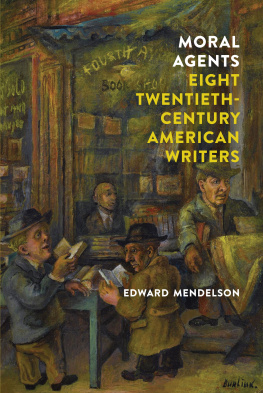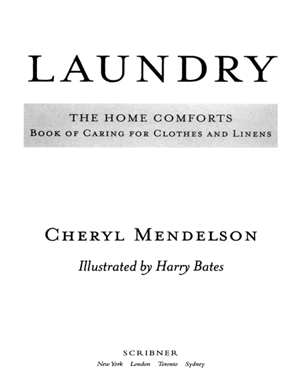
ALSO BY CHERYL MENDELSON
NONFICTION
Home Comforts
FICTION
Morningside Heights
Love, Work, Children

SCRIBNER
1230 Avenue of the Americas
New York, NY 10020
www.SimonandSchuster.com
Text copyright 1999, 2005 by Cheryl Mendelson
Illustrations copyright 1999 by Harry Bates
All rights reserved, including the right of reproduction in whole or in part in any form.
This Scribner Edition 2005
SCRIBNER and design are trademarks of Macmillan Library Reference USA, Inc., used under license by Simon & Schuster, the publisher of this work.
For information about special discounts for bulk purchases, please contact Simon & Schuster Special Sales: 1-800-456-6798 or business@simonandschuster.com
DESIGNED BY KYOKO WATANABE
Set in Bembo
Manufactured in the United States of America
3 5 7 9 10 8 6 4 2
Library of Congress Control Number: 2005051602
ISBN-13: 978-0-7432-7145-5
ISBN-10: 0-7432-7145-9
eISBN-13: 978-1-439-18856-9
Portions of this book were previously published in somewhat different form in Home Comforts.
CONTENTS
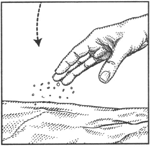
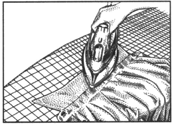
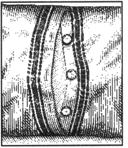
AUTHORS NOTE
This book contains material on laundering and the use and care of fabrics in the home originally published in Home Comforts: The Art & Science of Keeping House (1999), a general work on housekeeping nearly 900 pages long. Laundry unites in one convenient volume the long segment of Home Comforts called Clothwhich was devoted entirely to laundering, laundry products, and fabrics and fiberswith related discussions from other parts of Home Comforts on subjects ranging from mending to bed linens and carpets.
The material has been updated where recent developments have required changes in the original. I have also written a new introduction and a new chapter, expanded the index, here and there reorganized for increased clarity, and made other changes throughout, all with the goal of creating a comprehensive, practical, humane, and readable book on modern home laundering and the domestic use and care of cloth and linens.
PREFACE
How to Do the Laundry
Laundering is easily explained. Indeed, the basic steps of laundering have not changed for at least a century and a half.
Every week or so, when enough of your clothes and linens are soiled to make doing a wash worthwhile, you gather them all together in one place and separate them into loads, or heaps on the floor, of items that can safely receive similar laundering. Paying attention to fiber content and care labels, you sort them according to their color and dye-fastness, the type of cloth they are made of and the way they are madetheir sturdiness or fragilityhow dirty they are and what the dirt is, and other characteristics, watching out for stains and especially hard-to-remove soil as you go. These difficult spots you treat immediately, either with liquid detergent, a paste of detergent powder and water, or a product specially manufactured for the purpose. Once the loads are separated and stains treated, you wash the clothes in sudsy water that is cool, warm, or hot, depending on the kind of cloth. Sometimes, one or more garments need hand-washing, whether because they are so delicate or because they are not colorfast or are prone to shrinking or for some other reason. Most, however, you wash in your washing machine, one load after another. Then you dry each load, either in your dryer or on a clothesline, drying rack, or hanger. After the laundry is dry, some people will iron wrinkled things smooth. Garments and linens that will not be ironedall of them, in many householdsare hung or folded. All are then replaced in closets and drawers or on shelves, ready to be used again. At regular intervals, you repeat this series of stepsstoring, using, gathering, sorting, washing, drying, ironing and folding, restoring. Its simple.
Why, then, is this book more than four hundred pages long? Because each of these steps is a place where you can trip. The potential causes and kinds of missteps are remarkably numerous, and there are countless opportunities to fine-tune your methods. The more you know and the greater your experience, the fewer money-, time-, and labor-consuming errors you will make. A book like this cannot confidently claim to have included every fact or technique that someone might look for, but its pages are crammed with facts, some for beginners and others for experts, that will be useful in someones laundry. No one needs to know all of them. Many are about fabrics or linens or clothes or laundry facilities completely unlike yours. Some are geared toward standards that are irrelevant to your circumstances or possessions. For just as good cooking includes everything from hamburgers on your grill to Julia Childs Crpes Goures et Flambes, so laundering can be done either in a perfectly satisfying rough-and-ready way or with elegant finesseor something in between. What is best for your household depends on your own time, resources, needs, tastes, tolerances, goals, and belongings.
INTRODUCTION
Laundering is part of everyones life because clothes and linens are indispensable to comfort, health, and beauty. In spite of this, a massive de-skilling of the population in matters of cloth and its domestic care began in the last decades of the twentieth century and continues at an accelerating pace today. This is a trend worth resisting.
Contrary to nudist fantasy, the clothed body, in all but a very few circumstances, is more comfortable than the naked one. In hot weather, cloth prevents perspiration from irritating your skin and running into your eyes and mouth. A sweaty-wet cotton T-shirt cools you more than going shirtless, and it also protects you from sunburn. Clothes, after all, are ingeniously engineered cloth constructions designed to guard us from the discomforts of our environment: frostbite, scratches, bruises, mosquito bites, poison ivy, splinters, and a thousand other hazards. What we wear can simultaneously shield us against unwanted looks and touches and entice wanted ones. We wrap ourselves in cloth to stay warm and comfortable during the long hours of sleep, we lay it on our floors and wrap it around our furniture to cushion our limbs and feet while walking and sitting, and we drape our windows with it to regulate light and air for our comfort. Cloth does all this for us, and at the same time it is an astonishingly fertile means of expression for our aspirations to beauty, sociability, and individuality in our lives.
Because clothes and other fabrics are among our most intimate and prized possessions, the old maxim, who loves the end loves the means, applies forcefully to the arts of caring for and choosing cloth goods. Everyone, no matter how rich or poor or domestically uninclined, can not only benefit from acquiring laundry skills and learning about fabrics but will also find considerable satisfaction in doing so.
Next page

